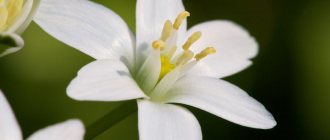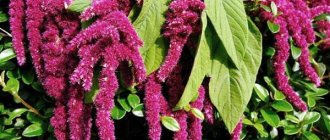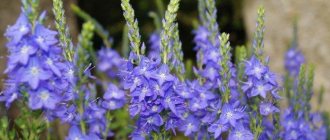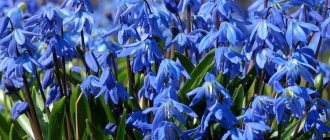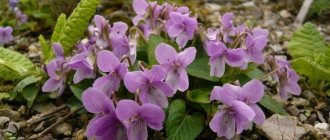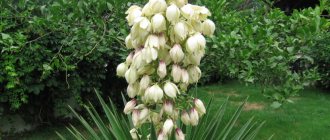general information
Oregano, hemlock, oregano - all these and many other similar names actually refer to the same heather shrub. Ledum is distributed throughout almost the entire Northern Hemisphere.
Ledum honey plant is widely used in folk medicine, and the beneficial substances in its composition are recognized even by official medicine. But remember that all its parts are poisonous, and the pungent aroma can cause weakness and dizziness.
The height of the bush ranges from 50 to 120 cm, depending on the species. Ledum has a superficial, but powerful and branched rhizome with equally powerful and branched stems. They are strong, but thin, and can be straight or creeping.
Over time, the shoots of wild rosemary become woody, but the young stems are covered only with reddish pubescence. Dense, dark and elongated leaves exude that same scent of dope. In spring, last year's wild rosemary shoots are covered with white or pink umbrella inflorescences.
Photo: yesofcorsa.com
Ural herbalist
Marsh rosemary
Marsh wild rosemary is an evergreen poisonous shrub from the heather family. It is popularly called bahun, wild rosemary, bugun, head, swamp hemlock, sleepy stupor, forest rosemary, bug grass and many other names. Thickets of wild rosemary become dangerous to humans during flowering - during this period, wild rosemary releases highly toxic substances into the air that poison the human body. Its smell causes nausea, dizziness and headaches. When using this plant for medicinal purposes, one must be extremely careful.
The marsh rosemary grows in forest and tundra zones, in the forest belt of mountains, in swampy coniferous forests, in moss swamps, and often forms dense thickets. It is adapted to life on very poor, acidic, highly moist soils. It lives mainly in the north of the European part of Russia, Western and Eastern Siberia, and the Far East.
Description
Marsh wild rosemary is an evergreen shrub plant with a superficial root system. Almost vertical aboveground shoots are numerous and can reach a height of 125 cm. Young shoots are densely pubescent with red hairs. The leaves are short-petiolate, alternate, overwintering, leathery, linear-oblong, with edges turned down, reaching a length of 1.5–4.5 cm. The leaves are dark green and shiny on the upper side, covered with red down on the lower side. The flowers are white, regular, five-membered, approximately 1 cm in diameter, with 10 stamens, on long glandular pubescent pedicels, collected in corymbose inflorescences of 16–25 flowers. The fruit is a five-locular, multi-seeded, glandular-pubescent capsule, dark, oblong-oval, 3–8 mm long.
Marsh rosemary
About collection and drying
Marsh wild rosemary blooms in May-July and bears fruit in July-August.
Leafy non-lignified shoots of the current year up to 10 cm long, collected in August-September, during the ripening of the fruits, are used as medicinal raw materials. They are torn off by hand or cut using pruners.
The collected shoots are dried in the attic or under a canopy in the shade; the room should be well ventilated. The raw materials are spread in a thin (5–7 cm) layer on fabric or paper and turned over regularly. You can also dry raw materials in special dryers at a temperature of 30–40 °C. All work must be carried out in respirators or gauze bandages for no more than 2-3 hours a day, using caution.
Finished medicinal raw materials are stored separately from other plants in cardboard boxes or paper bags in a dry room. The maximum shelf life is 2 years.
Application in medicine
All parts of wild rosemary, especially the roots, contain poisonous essential oils, as well as glucosides, andromedotoxin, coumarins, flavonoids, tannins, phytoncides, vitamin C, micro- and macroelements.
The medicinal properties of wild rosemary are used in folk medicine to treat whooping cough, scrofula, rhinitis, dysentery, malaria, scabies, and weeping eczema. Its leaves help with colds, bronchial asthma, angina pectoris, pulmonary tuberculosis, gout and dermatomycosis. Products based on wild rosemary have diuretic, tonic and anthelmintic effects. An alcoholic infusion of flowers is drunk for tuberculosis and suffocation, and also rubbed in for rheumatism. An infusion of the herb is used as a diaphoretic for colds, bronchitis, bronchial asthma, cough, and tuberculosis.
Treatment with products based on wild rosemary should be agreed with a doctor, since the plant can cause great harm to the body, and in no case should its dosage be exceeded.
Infusion for colds
Ingredients:
1 tsp. dried wild rosemary herb, 200 ml of water.
Cooking method:
grind the wild rosemary herb, pour boiling water over it, let it brew for 30 minutes, then strain.
Application:
take 1 tbsp orally. l. 3–4 times a day.
Infusion for wounds, frostbite, insect bites and eczema
Ingredients:
2 tbsp. l. marsh rosemary leaves, 200 ml of water.
Cooking method:
grind the wild rosemary leaves, pour boiling water over it and let it brew for 45 minutes, then strain and bring the volume of the infusion to 500 ml with boiled water.
Application:
rub into sore spots.
Infusion for arthritis, arthrosis, gout and radiculitis
Ingredients:
12 g of wild rosemary herb, 200 ml of water.
Cooking method:
Grind the wild rosemary herb, pour boiling water over it and let it brew for 20 minutes.
Application:
rub into joints.
Rosemary oil instead of nasal drops
Ingredients:
1 tbsp. l. wild rosemary flowers, 100 ml of vegetable oil (olive or sunflower).
Cooking method:
pour wild rosemary flowers with vegetable oil, let it brew in a dark place for 21 days, then strain and pour into a dark bowl.
Application:
instill 1-2 drops into the nose 2-3 times a day for acute and chronic rhinitis or sinusitis.
Ledum oil for radiculitis, arthritis or arthrosis deformans
Ingredients:
1 tbsp. l. wild rosemary flowers, 100 ml of vegetable oil (olive or sunflower).
Cooking method:
pour wild rosemary flowers with vegetable oil, bring to a boil and let simmer for 1 minute over low heat, then remove from heat and let steep for 1 day.
Application:
Rub the oil into your lower back or joints.
Ledum oil for acne, eczema and lichen
Ingredients:
2 tbsp. l. dried wild rosemary herb, 5 tbsp. l. sunflower oil.
Cooking method:
chop the wild rosemary herb, pour in sunflower oil, then cover and let it brew in a warm place for 12 hours.
Application:
use externally.
Tea for non-productive cough and shortness of breath
Ingredients:
1 tbsp. l. dried wild rosemary herb, 1 tsp. nettle leaves, 200 ml water.
Cooking method:
chop and mix the herbal ingredients, pour boiling water over them and let steep for 15 minutes.
Application:
drink half a glass 3 times a day for 2 to 4 weeks.
Ointment for arthritis, arthrosis and radiculitis
Ingredients:
200 g internal pork fat, 25 g wild rosemary leaves.
Cooking method:
put the pork fat in a clay pot, add chopped wild rosemary leaves, cover with a lid and simmer in the oven at 100 °C for 2 hours. Then cool slightly, strain and pour the ointment into a container with a lid and a wide neck.
Application:
use externally to relieve pain from arthritis, arthrosis and radiculitis, as well as neuralgia and myositis. Store the ointment in the refrigerator.
Ointment for scabies
Ingredients:
500 g pork fat, 1 tbsp. l. wild rosemary leaves, 1 tbsp. l. hellebore root.
Cooking method:
chop the vegetable ingredients, mix them with pork fat in a heat-resistant container and place the container in the oven with minimal heat for 12 hours. Then strain and pour into a glass container.
Application:
Apply ointment to the affected areas 3 times a day.
Alcohol tincture for gout, rheumatism, arthritis, eczema, bronchitis and bronchial asthma
Ingredients:
1 tbsp. l. wild rosemary herb, 5 tbsp. l. alcohol or vodka.
Cooking method:
Grind the wild rosemary herb, add alcohol and let it brew in a warm, dark place for 1 day.
Application:
use to rub your joints or back.
A decoction for the treatment of the respiratory, cardiovascular and genitourinary systems
Ingredients:
1 tsp. marsh rosemary leaves, 200 ml of water.
Cooking method:
chop the wild rosemary leaves, add water, boil in a water bath for 15 minutes and let it brew for 45 minutes. Then strain the broth.
Application:
drink half a glass of the decoction 3 times a day for 1–2 months.
Expectorant herbal tea
Ingredients:
1 tbsp. l. wild rosemary leaves, 2 tbsp. l. marshmallow root, 2 tbsp. l. coltsfoot leaves, 200 ml of water.
Cooking method:
chop and mix the herbal ingredients, take 2 tsp. vegetable mixture, pour boiling water, let it brew for 20 minutes and strain.
Application:
drink half a glass 3-4 times a day as an expectorant.
Herbal mixture for coughs, colds, bronchial asthma and rheumatism
Ingredients:
25 g of wild rosemary herb, 15 g of stinging nettle, 1 liter of water.
Cooking method:
chop and mix the herbal ingredients, pour boiling water over it and let it brew for 10–15 minutes.
Application:
drink half a glass 5-6 times a day for the above diseases.
Herbal mixture for the treatment of dysentery
Ingredients:
2 tsp. marsh rosemary leaves, 5 tsp. marshmallow root, 1 liter of water.
Cooking method:
chop and mix the herbal ingredients, pour boiling water over it and let it brew for 10–15 minutes.
Application:
drink 1 tbsp. l. with an interval of 2 hours for dysentery.
Other uses
The leaves of wild rosemary can be used to kill flies and other insects by fumigating the room with them. Ledum twigs and leaves are placed in clothes to repel moths. Decoction, infusion, powder and smoke of wild rosemary destroy mosquitoes, moths and bedbugs and repel rodents.
Interesting Facts
Once upon a time, in taverns, wild rosemary herb was specially added to beer and vodka to intoxicate visitors more strongly in order to clean out their pockets.
Contraindications
Treatment with wild rosemary must be agreed with a doctor so that the benefits of such treatment outweigh the harm. You should not take medications based on wild rosemary under the age of 18. It is necessary to strictly observe the dosage, since exceeding it can cause serious consequences from poisoning to paralysis of the heart muscles. If you experience dizziness, increased irritability, or problems with the intestines and stomach, you should immediately stop taking wild rosemary products.
Types of wild rosemary
The wild rosemary genus is not so diverse and rich. There are only a few main varieties of it, and even fewer in Russia. Let's talk about them!
Large-leaved wild rosemary
The eastern guest prefers rocky and mountainous terrain. It grows in Japan, Korea and, of course, the Far East. This is a compact variety that grows on average to 50-60 cm, although sometimes taller specimens are found. The leaves of this wild rosemary are really large for its genus - up to 4 cm.
Photo: happy-nokia.ru
Marsh wild rosemary
This is a resident of regions with a temperate climate. It is branched, quite spreading and tall - up to 120 cm in height. The bush grows actively and blooms at the end of spring. The aroma of marsh wild rosemary is slightly less pungent.
Photo: mrfilin.com
Transbaikal wild rosemary
A distant relative of the rhododendron has brighter and more decorative flowering. Its pink flowers can even be seen in bouquets. The bush itself is very tall and branched, and in some cases reaches up to 2 m.
Photo: multiurok.ru
Greenland wild rosemary
The most frost-resistant species that is not afraid of any cold weather at all. It has very tough, medium-sized shoots up to 90 cm, which lie towards the ground as they grow. The stems are densely and densely covered with needle-like fleecy leaves. Umbrella inflorescences of small cream flowers reach up to 6 cm in diameter.
Photo: lesjardinsdemalorie.be
Lilies of the valley (50 photos): types, planting and proper care
Choosing a place and soil for wild rosemary
Ledum can take root almost anywhere, but it is better to plant it in the shade, as it does not like sunlight.
Lush inflorescences look advantageous against the background of spruce, pine or thuja, so for a decorative effect you can plant them next to these plants. Since its homeland is a swamp, the soil for rosemary, especially swamp, should be acidic and loose. To do this, the planting hole is filled with a mixture of high-moor peat (3 parts), sand (1 part) and coniferous soil or tree bark (2 parts). Species such as large-leaved wild rosemary and Greenland rosemary can grow even on poor and sandy soils; for them, the substrate is prepared according to the same principle, but with a predominance of sand.
Caring for wild rosemary
Considering the conditions in which wild rosemary lives in nature, it does not need any special care. Moreover, the plant has excellent immunity and even repels pests on its own.
Temperature and lighting
Ledum is not afraid of frost and winters well in open ground. Occasionally, in a snowless winter, young shoots may suffer, but they can simply be thinned out in the spring. The plant is indifferent to the sun, partial shade or even strong shading.
Photo: agronom-world.ru
Watering
Ledum prefers damp areas and ponds, so in any other place regular and intensive watering is required. It can only be reduced during prolonged rainfall.
Photo: ericaceae.org
The soil
The soil should be loose and quite acidic. You can add sphagnum or just pine needles. Periodically loosen the soil and remove weeds, but remember that the root system of wild rosemary is very close to the surface.
Photo: klkfavorit.ru
Fertilizers and fertilizing
Several times a season, wild rosemary can be fed with mineral fertilizers. But this is not necessary and is rather relevant for the blooming Transbaikal species.
Photo: web-zoopark.ru
Cowberry
An evergreen shrub from the lingonberry family, up to 30 cm high, with a creeping rhizome. The leaves are alternate, overwintering, thick, leathery, with glands in the form of brown dots on the underside. The flowers are pale pink, in short drooping racemes. The fruit is a dark red berry. Blooms in May-June. Distributed in mixed and taiga forests, swamps, and moss-lichen tundra.
In medicine, lingonberry leaves are used, which should be collected before flowering. Lingonberry leaves are used as a diuretic for low acidity, liver disease, gout, bedwetting in children, rheumatism, and kidney stones. With short-term use of an infusion of lingonberry leaves, the blood sugar level decreases. Boiled lingonberries with honey are recommended for tuberculosis. Due to the benzoic acid content in lingonberries, the berries can be stored without sugar. The peoples of the Northern Urals - the Khanty and Mansi - collect the juice of lingonberry leaves during flowering and use it to treat radiculitis: rubbed into sore spots for 5-6 minutes 2-3 times a day.
Planting and propagation
In nature, wild rosemary reproduces by seeds from small capsules, which themselves crack as they ripen. An adult plant can be propagated by layering. To do this, you need to dig a flexible branch into the soil, leaving the top free, and just wait for rooting.
Large bushes can be cut into sections and then immediately planted in new places. And summer healthy semi-lignified cuttings take root well in loose, nutritious soil, but this takes a long time, and they will only be able to be transplanted outside next spring.
The optimal depth of the planting hole is 40-60 cm, and good drainage is required. The distance between the bushes should be at least 60-70 cm. After planting, it is recommended to mulch the top with peat.
Photo: fototerra.ru
Loosestrife (50 photos): types, planting and care in open ground
And the name suited him
Ledum in Siberia are deciduous rhododendrons that bloom profusely in early spring. This is wrong, but it is so generally accepted that I, without further ado, will begin to call them that. Moreover, real wild rosemaries (Ledum) and rhododendrons (Rhododendron) are so close that not all botanists recognize them as separate genera. Indeed, wild rosemaries and rhododendrons have a lot in common. How they differ, other than the size of the flowers, I personally don’t know. They are all shrubs. With the onset of frost, the leaves that have not fallen for the winter are rolled up into tubes. The flowers of real wild rosemary, although small, have a structure typical of all rhododendrons: a corolla of five petals and long, far-protruding stamens, characteristic of both of these shrubs. And even if we touch on their agricultural technology, then here they have similar preferences. As for the Siberian rhododendrons called wild rosemaries (and there are 4-5 species), their differences are even more blurred. If you don’t look too closely at the details, then from a distance they practically look alike. And their flowers, with the exception of the Schlippenbach rhododendron, are difficult to distinguish even up close. Dahurian rhododendron (R. dahuricum) - due to its prevalence, this particular species most often falls under the name wild rosemary. Its discontinuous range extends from Altai to Sikhote-Alin. Deciduous shrub with a usual height of 70-120cm (rarely up to 2m). The leaves are elliptical, up to 6 cm long, up to 2 cm wide, on short petioles. In autumn, most of the leaves turn yellow and fall off, but a few pieces at the top remain to overwinter on the bush. Flowers with a diameter of about 4 cm in various shades of pink, occasionally almost white, are fragrant. Flowering begins a week before the leaves bloom on the birch, so the flowering of the shrub is very noticeable. In nature, flowering lasts up to a month, in culture it blooms for about 15 days. Photophilous. It is completely winter-hardy, but winters with thaws cause premature awakening and subsequent death of flower buds. Grows well in ordinary garden soils with the addition of high-moor peat. Ledebour's rhododendron (R. ledebourii) is a semi-evergreen shrub with a usual height of 60-90cm (maximum up to 2m). The leaves are elliptical, rounded or blunt-topped, 1-4 cm long, up to 2 cm wide, leathery olive-green. The apical leaves usually remain for the winter and are gradually replaced by new ones in the spring. Grows in Altai and Sayan Mountains. The flowers are pinkish-violet or lilac-pink, 3-4.5 cm in diameter. It blooms in early May, when the forest turns green. It blooms for 15-18 days. Pointed rhododendron (R. mucronulatum) is a deciduous or semi-evergreen shrub 80-150 cm high (in nature up to 3 m). It grows in the south of Primorsky Krai, Korea, and northeast China. The leaves are oblong-elliptical, 5-7 cm long, up to 2 cm wide. The flowers are purple-pink, wide open, 4-5 cm in diameter. It blooms in early May for more than two weeks. Sichotense rhododendron (R. sichotense) - semi-evergreen, 60-100 cm. The leaves are olive-green, round-elliptical, 2-4 cm long, up to 2 cm wide. When cold weather sets in, they roll up into tubes. The flowers are broadly bell-shaped, light purple or violet-pink, up to 4.5 cm in diameter. It blooms in mid-May and blooms for about half a month. It grows in the Primorsky Territory in the Sikhote-Alin mountains. Schlippenbach's rhododendron (R. schlippenbachii) is a deciduous shrub 100-200 cm high (in nature reaches 5 m). The leaves are obovate, 5-9 cm long and 3-6 cm wide, green, turning yellow or red before leaf fall. The flowers are wide open, up to 8-10 cm in diameter, light lilac or pale pink with dark red specks. It blooms in early May and lasts for about three weeks. Distributed in the Russian Far East - in Primorye, Korea, China, Japan.
Using wild rosemary in the garden
Ledum is not very decorative, but it is sometimes planted in wet, swampy areas where other plants do not take root. In addition, he feels good near bodies of water. It can also be planted in the shade between tall trees and on rocky areas. And also - use as a hedge when zoning.
Photo: zen.yandex.ru
Castor bean (50 photos): types, care and planting in open ground
Diseases and pests
In a favorable environment, diseases do not affect the plant.
If there is not enough nitrogen and potassium, with stagnant moisture, mixed chlorosis - the leaves turn yellow in spots. In this case, eliminate excess moisture, provide drainage and spray the bush with a solution of iron sulfate: 7.5 g per liter of water.
Red spots along the veins on the leaves appear when there is a lack of soil nutrition. Fertilizing with ammonium fertilizers or potassium nitrate will correct the situation.
After severe frosts, the leaves on an uncovered plant die off, so you should not remove the winter shelter from foliage and spruce branches too early.
insect pests can settle on rhododendron :
Rhododendron bug, spider mite, Asian garden beetle. Control measures: spraying with diazinon.
Mealybug. Spraying with karbofos eliminates it.
Furrow weevil. Karbofos helps against it, as well as basadine, diazinon and furadan.
Narrow-winged miner moth . In this case, the bushes are fumigated with sulfur.
If a properly cared for Daurian rhododendron on your site pleases with abundant April flowering, know that at the same time throughout the Far East, in the Siberian taiga valleys, in the Korean mountains and on the hills of Manchuria, its wild counterparts bloom in the same way, confirming: here it is, spring!
Ledum – photo
Keep an even larger selection of photos to make it easier for you to identify wild rosemary and finally decide what you think about it!
Photo: nat-geo.ru
Photo: oir.mobi
Photo: drive2.ru
Photo: flo.discus-club.ru
Photo: mrfilin.com
Photo: poleznii-site.ru
Photo: uborka-v-dome.ru
Photo: plantarium.ru
Photo: fotoload.ru
Photo: domsvechei.ru
Photo: zhenskiye-sovety.ru
Photo: kustroz.ru
Photo: flo.discus-club.ru
Photo: nat-geo.ru
Photo: flower.onego.ru
Photo: na-dache.pro
Photo: svb28.ru
Photo: les.media
Photo: zen.yandex.ru
Photo: zen.yandex.by
Photo: zen.yandex.ru
Photo: blotos.ru
Photo: viplor.ru
Photo: distano.ru
Did you like the post? Subscribe to our channel in Yandex.Zen, it really helps us in our development!
Description
The shrub has dark green leaves, up to four centimeters long. They are oblong in shape with curved edges. The wild rosemary flower blooms with reddish or white small flowers that are attached to long stalks. They are collected in multiple umbrella-shaped brushes. During flowering, a strong aroma emanates, sometimes intoxicating, and can cause dizziness. After flowering, the fruits ripen. They are oblong in shape with many small, light yellow seeds.
The presented photos show what wild rosemary looks like. This plant is used in infusions, decoctions, and less commonly used in powder form. It is used to prepare ointments. To do this, animal fats and plant extracts are added to the composition.
A remedy for lotions and baths is prepared from wild rosemary. They make tinctures that have a pronounced anti-inflammatory, antibacterial, and antimicrobial effect. Plants contain substances that have an analgesic effect.
Ledum is a branched shrub with evergreen, leathery leaves. The shoots are dark gray in color and grow up to 80 cm. The entire, elongated leaves have a curled edge and an alternate arrangement.
After pollination of bisexual flowers. The fruit begins to form, which after ripening resembles a box with five nests. The fruit splits at the base and small, winged seeds appear.
Superstitions and signs
There are many legends about wild rosemary, and there are many superstitions and signs. In this regard, most flower growers do not dare to decorate their home with it. However, this plant is quite useful: it helps to improve the health of the body and cleans the air of pathogenic microbes. But be careful, because if the bush is in the room during flowering, then all the people living there will experience severe headaches. This is connected with the sign that because of this plant, household members become irritable, nervous and begin to have various problems. However, if you leave a few flowers on the bush, it will be able to cleanse the house of negative energy.
TWO TYPES of wild rosemary. RHODODENDRON. SWAMP Ledum.
Watch this video on YouTube

